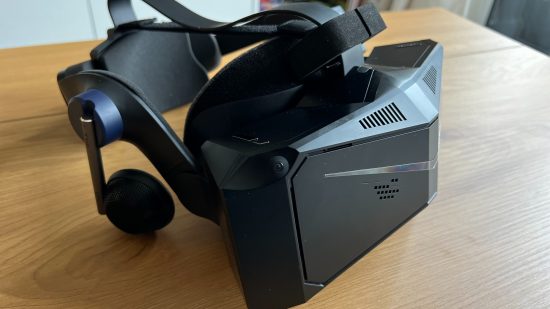Our Verdict
A great VR headset for hardcore enthusiasts with the gaming PC to back it up, the Pimax Crystal falls short in it's standalone mode, but can't be touched for visual quality when playing PCVR games.
- 2880p per eye display
- 35 PPD
- 120Hz refresh rate
- Difficult first setup
- Standalone offerings are lacking
Looking at the virtual reality gaming landscape right now, it’s hard not to be excited about what the future holds. We’re long past the point of it being just a gimmick thanks to multiple triple-A releases, and the Pimax Crystal is a product that is only for that hardcore VR crowd who will want to play every experience using the best equipment possible. If you can look past a nauseating price point, the quality it has is unmatched by any VR experience you can buy right now.
I don’t mean to highlight its price as a negative, because the Pimax Crystal is a premium piece of hardware that was made without compromises to reduce its price or target a wider audience. Simply put, the Pimax Crystal is one of the best VR headsets you can buy right now and has the most stunning display, with no one else coming close. I would just be cautious in recommending it to anyone who isn’t familiar with the hobby and wants to exercise caution over the cash they’re willing to spend.
Why you can trust our advice ✔ At PCGamesN, our experts spend hours testing hardware and reviewing games and VPNs. We share honest, unbiased opinions to help you buy the best. Find out how we test.
Pimax Crystal specs
Here are the Pimax Crystal specs:
| Pimax Crystal Specs | |
| Resolution | 5750×2880 (2880×2880 per eye) |
| Display | QLED |
| Optics | Aspheric Lenses |
| IPD Range | 58-27mm |
| Refresh Rate | 120Hz (Up to 160Hz in experimental mode) |
| Platforms | PCVR via Pimax Store, SteamVR, Standalone |
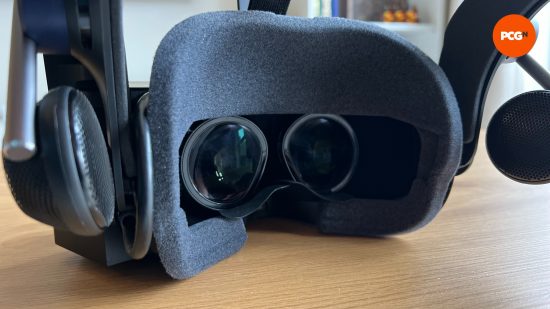
Pimax Crystal design
Setting up the Pimax Crystal is a pain. There’s no nice way to put it, but unpacking the headset is overwhelming as you’re quickly surrounded by components and cables with little idea of how to connect everything. I would compare the setup to that of the original PSVR, where the amount of cables and ports needed is a little inconvenient, and leaving everything in place to come back to later on just made my desk look constantly cluttered. Once I had been through the process a few times, it did become second nature, though, and I can now go from having everything unplugged, to fully connected within five minutes.
In the Crystal, Pimax creates an incredibly comfortable VR headset that needs next to no adjustments right out of the box. The Crystal is a heavy headset, coming in at around 1.16kg with a battery installed and 1.04kg without, but the way it sits on your head distributes this weight evenly. However, I understand the complaints that it is too heavy, and comfort in VR is entirely subjective so all I can truly say is that I found the Crystal to be a very pleasant experience.
The Pimax Crystal comes packed with two rechargeable controllers which are essentially the same as the Oculus Touch, so if you have familiarity with those, it should feel natural to use these. If not, think if the controllers are included with the Meta Quest 2. They’re light, and responsive but do feature a slightly jarring halo that I only realized bothered me when moving to the Quest 3 controllers because they’ve been removed.
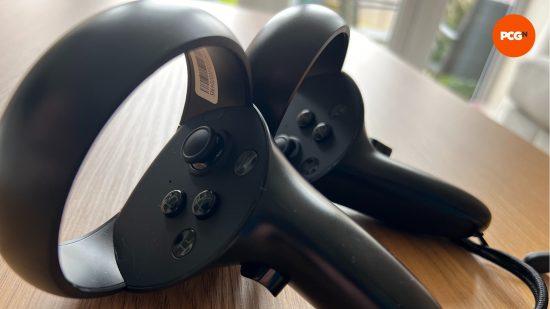
On the headset itself, there is a 3.5mm jack port, three microphones, and a set of DMAS off-ear headphones that provide a really clear audio stream that pushes immersion that one step further. Over the bridge of the nose, there is a rather flimsy silicone barrier that I’m not entirely sure has a purpose. If it was designed for comfort, it plays no role, but if it was a decision to keep air from circulating the headset, I would argue that it creates a heat pocket that caused me some trouble as a glasses wearer.
On that point, finding the right physical comfort angle of the Pimax Crystal took a little longer since I wear glasses. Unlike the Quest 2 and 3, there is no simple solution designed for aiding glasses’ comfort, and I understand that it’s difficult to come up with a one-size-fits-all approach. Despite this, the general comfort levels of the Crystal are still fantastic, and the included strap is great for making micro-adjustments to find the perfect spot for it to sit on your head and distribute its weight.
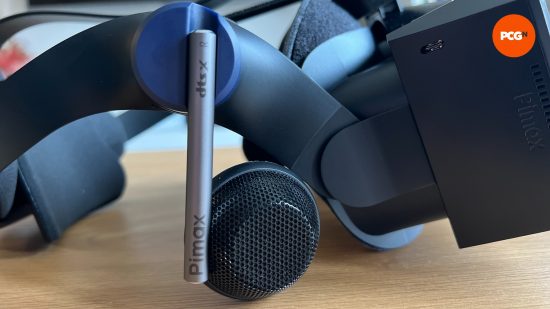
Pimax Crystal performance
While the Pimax Crystal is both a tethered PCVR and a standalone headset, the integrated Pimax store is barren. There are virtually no interesting apps or games that could be considered a selling point of the Crystal. When tethered, you have access to a wider selection of games in the Pimax store, as well as being compatible with SteamVR.
This creates an internal conflict because, why go to the lengths of supporting a standalone mode, but then fail to support it with the right or any apps? There is also a hardware consideration that needed to be made to add a standalone mode, and I feel like the cost and weight could have both been reduced had it stayed the course as PCVR only.
That’s my one and only ‘performance’ related gripe because outside of this, the Pimax Crystal is an elite VR headset. As much as I love my Meta Quest 3, the quality difference is night and day. Every aspect of gaming on the Pimax Crystal feels smooth. There are next to no tracking mishaps, calibration quirks, or graphical glitches when playing any games.
Where the Quest 3 sometimes feels like it’s reaching to produce high graphical quality, often getting warm and in extreme cases running slow, the Pimax Crystal steams right ahead with no slowdown. I would liken the difference in graphical quality to that between the PS3 and PS4. The Quest 3 is the PS3 late in its life, on the verge of something great but slightly limited by technology whereas the Crystal is cleaner, sharper, and more detailed like the PS4, but not so technically advanced that it’s impossible to comprehend ever looking back for the sake of convenience.
Streaming Half-Life: Alyx into the Quest 3 via Steam Link was easy enough, and it was nice to have the freedom of movement, but I am in a fortunate position whereby I can easily create a large playspace right by my gaming rig, and I would rather have the visual quality increased massively, for the sake of having a DisplayPort cable trailing off towards my PC. Playing Alyx natively in the Pimax Crystal was the clincher that made me realize that despite the convenience of a tool like Steam Link, it doesn’t compare to what a headset like the Crystal can offer.
For any game that requires you to be stationary, say racing or flight sims, the Pimax Crystal can also be transformative in how you see these games. I’ve never been the biggest flight sim fan, but experiencing it through a Crystal is a breathtaking experience that’s impossible not to crack a smile at. I’m much more familiar with racing sims, and again the Crystal offers an unrivaled level of image quality and immersion thanks to its powerful display and speakers.
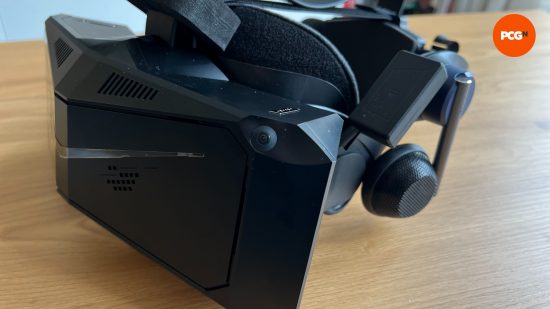
Another fantastic performance feature of the Pimax Crystal is the automated IPD tracking system. With a range of 58-72mm, there is plenty of consideration given to how each player will be unique in their needs. Comparing this to the Quest 3’s range of 53-75mm, it may seem inferior, but the fact that the crystal can automatically track your range offers a completely personalized experience. It’s also possible to set a more precise number compared to the whole-numbers-only approach of the Quest 3.
Pimax is very clear in stating that the Crystal features the most pixels of any VR headset on the market, with 2880×2880 per eye, totaling a combined 5760×2880 resolution. Another contributing factor to the visual quality of the Crystal headset is has nearly double the typical PPD (pixel-per-degree).
While I expect PPD to become a genuine quality factor in VR soon, it’s still a relatively new talking point, and while Pimax is quick to brag about its 35 PPD display, it’s hard to compare that to other headsets when the data tends to produce cloudy results. In layman’s terms, the Pimax Crystal is innovating the traditional VR display, and the likes of Meta, Valve, and Pico are playing catch up.
With refresh rates of up to 120Hz, gameplay is exceptionally smooth. Granted, your PC gaming rig will play a big role in this, and it’s advised that you have at least an Nvidia GeForce RTX 30-series card in your rig.
No matter what game I put in front of the Pimax Crystal, it was up to the task of bringing an unmatched performance that was a joy to behold. Despite the weight, I never struggled to hit hour-long sessions, which is my self-imposed limit when it comes to VR gaming. There are tweaks I would make to the architectural decisions made when the Pimax Crystal was being designed, but these are no reflection of the sheer quality of the Crystal headset.
Should you buy the Pimax Crystal?
If you are a hardcore VR player, who is looking for the best visual experience with PCVR, yes, the Pimax Crystal is a must-buy, even at its lofty price point of $1,699 / €1,499.
If you’re just dipping your toes into VR as a hobby, or don’t have the gaming hardware to support PCVR, stick to something like the Meta Quest 3 and save yourself a lot of trouble (and money).
In an ideal world, as I’ve already alluded to. A dedicated PCVR-only model of the Crystal would be a welcome sight and could likely bring the initial cost of entry down. The alternative is that Pimax greatly improves its standalone offering with more apps and games to justify the inclusion of this mode.
Verdict
The Pimax Crystal is unmatched when it comes to visual quality with its class-leading display. However, it’s only really useful as a PCVR headset, as its standalone options are severely lacking. Its price point puts it out of reach for most people but for those serious about VR who want nothing less than the best, the Pimax Crystal stands alone.
